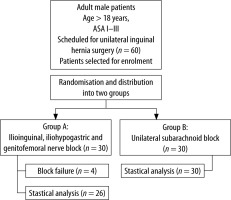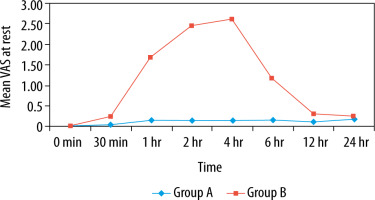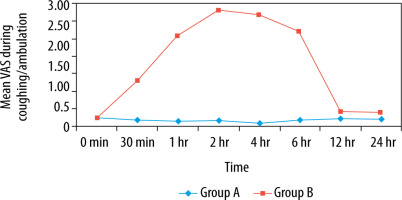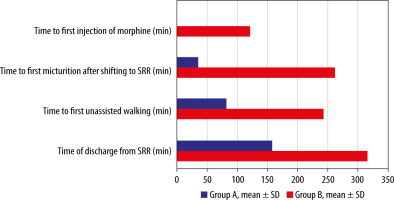Inguinal hernia repair is one of the most common procedures in general surgery. It is estimated that 20 million inguinal hernia repairs are performed globally every year [1]. Spinal anaesthesia is the most widely used modality of anaesthesia during inguinal hernia repair surgery, but sometimes it leads to delayed recovery and ambulation. The introduction of ultrasound and the concept of Enhanced Recovery after Surgery (ERAS) has revolutionized the practice of anaesthesiologists to provide better anaesthesia with a better postoperative outcome and pain relief.
Spinal anaesthesia is widely preferred because it provides intense sensory and motor blockade [2]. However, it is not an ideal anaesthetic technique for fast-track ambulatory surgery due to concerns regarding undesirable haemodynamic responses, urinary retention, postdural puncture headache, and prolonged recovery and hospital stay [3, 4].
A triple nerve block is one of the effective modalities for anaesthesia in inguinal hernia surgery with a lower incidence of nausea/vomiting and urinary retention, less need for postoperative analgesics, shorter length of hospital stay, and greater patient satisfaction than neuraxial regional anaesthesia [3]. Ilioinguinal iliohypogastric and genitofemoral nerves have a variable origin, course, and distribution in the inguinal region [5, 6]. Consequently, the inguinal region also receives sensory innervation from the genitofemoral nerve. The addition of genitofemoral nerve block to ilioinguinal and iliohypogastric nerve block improves the quality of analgesia for surgery in the inguinal region. The combined technique of blocking ilioinguinal, iliohypogastric, and genitofemoral nerves not only improves the quality of analgesia but also reduces perioperative opioid requirements and its associated side effects [7–9]. It also facilitates inguinal herniorrhaphy in an ambulatory anaesthesia setting [10, 11]. Ultrasound-guided blocks of the ilioinguinal and iliohypogastric have been associated with a higher probability of block success and a lower volume of required local anaesthesia [12–14].
The study aimed to evaluate the efficacy of ultra-sound-guided triple nerve block (ilioinguinal, iliohypogastric, and genitofemoral) versus unilateral subarachnoid block for inguinal hernia surgery in male adult patients.
The primary objective was to compare the postoperative analgesic efficacy (visual analogue scale [VAS] scores at rest and during coughing/ambulation). The secondary outcomes were time to first rescue analgesia with morphine, the total dose of morphine used as rescue analgesia, urinary retention, or time to first micturition, time to first unassisted walking, and time to discharge from the surgical recovery room. The total duration of stay in the hospital was also recorded. Other adverse effects like nausea/vomiting, pruritus, respiratory depression, and urinary retention were also considered.
METHODS
The present study was undertaken as a prospective, randomized controlled trial that was conducted after obtaining approval from the Institutional Ethics Committee prior to enrolment of the patients. The study is in accordance with the Declaration of Helsinki. Sixty patients were enrolled in the study and were randomized to achieve either a subarachnoid block or the triple nerve block. The sample size was estimated to detect a difference of 2 in VAS scores between both groups. The sample size for the present study was calculated to be 26 patients in each group at a power of 95% and a type I error of 0.05. It was decided to include at least 30 patients per group to compensate for possible patient drop, and therefore 60 patients were enrolled for the present trial.
After giving written informed consent, 60 male patients with ASA physical status I–III, with age > 18 years were included in the study. Patient refusal, ASA grade IV or above, body mass index (BMI) > 30, any allergy or contraindications to any of the study drugs, pain or chronic analgesic administration in the preoperative period, previous surgery in the inguinal region, patients with coagulopathy, non-reducible, strangulated, complicated hernia or emergency surgery, systemic infections or infection at local needle site insertion, any contraindications to subarachnoid block, inability to understand the VAS scoring system, and failed block were excluded from the study. Randomization was done by coded, sealed envelopes, and patients were divided into 2 groups to receive either subarachnoid or triple nerve block (Figure 1).
All the patients were examined, and a pre- anaesthesia check-up was performed pre-operatively. The patients meeting the inclusion criteria were enrolled for the present trial after giving written informed consent. All the patients were given an explanation of the VAS in their vernacular language. Pain score (0 – no pain, 10 – worst imaginable pain). The VAS was explained to the patients by drawing a 10-cm-long horizontal line divided into equal segments of 1 cm each. The patients were instructed to mark zero when no pain was perceived and 10 when they perceived maximum intolerable pain. All the patients were kept nil per os (NPO) for a period of 8 hours and were premedicated with oral pantoprazole 40 mg and alprazolam 0.25 mg on the night before surgery and at 6 a.m. on the day of surgery.
After taking the patient to the operating theatre an intravenous line was established and started with a crystalloid infusion of 0.9% normal saline. Monitoring was initiated with a multipara monitor displaying the electrocardiogram (ECG), heart rate (HR), non-invasive blood pressure (NIBP), and continuous pulse oximetry (SpO2) in all the patients. Patients were randomized to achieve either ultrasound-guided triple nerve block (Group A) or subarachnoid block (Group B).
In Group A, an ultrasound-guided triple nerve block was performed by a senior consultant, on the side to be operated, with the help of a portable SonoSite MicroMaxx machine. A high-frequency linear ultrasound probe (6–13 MHz) was used. After preparing the abdomen and ultrasound probe in a sterile manner, the lateral end of the probe was placed just above the anterior superior iliac spine (ASIS). The orientation of the probe was kept perpendicular to the inguinal ligament. Once the probe was placed in this position, the hyperechoic shadow of the ASIS was visualized. The probe was then tilted until all 3 layers of muscles: transverse abdominis, internal oblique, and external oblique, were visualized. The peritoneum was visualized as the fascial layer underneath the transverse abdominis muscles. The splitting of fascial layers between transverse abdominis and internal oblique muscles was visualized, and it is this fascial plane through which the ilioinguinal and iliohypogastric nerves pass. With an in-plane technique, a Sono Plex Stim cannula (21 G × 100 mm, Pajunk, Germany) was inserted from the lateral end of the probe. Once the tip of the needle was visible the fascial plane injection of ropivacaine 0.5% 10–15 mL was administered until the nerves were surrounded by local anaesthetic. Similarly, the genital branch of the genitofemoral nerve was also blocked using ultrasound. The orientation of the probe was kept perpendicular to the inguinal ligament. The final position of the probe was about one finger breadth lateral to the pubic tubercle. The spermatic cord was visualized, which is oval or circular with 1 or 2 arteries within it (the testicular artery and the artery to the vas deferens). The vas deferens are also seen as a thick tubular structure within the spermatic cord. An out-of-plane technique was used with the needle approaching the skin from the lateral aspect of the probe. Because there is anatomical variation found with the location of the genital branch of the genitofemoral nerve, a 5-mL injection of 0.5% ropivacaine was made inside and outside the spermatic cord. The incision line was also infiltrated with a 5 mL injection of 0.5% ropivacaine 10 minutes before the start of surgery. The total volume of drug used in each patient was 20–25 mL. The total dose used was well within normal limits. The effectiveness of the block was assessed by pinprick sensation in the sensory dermatomes along the lower abdomen, inguinal region, the upper and medial part of the thigh, and some parts of genitalia (L1–L2) after 15–20 minutes of administering the block. Patients were sedated with an injection of midazolam in a dose of 0.05 mg kg–1 to maintain a Ramsay sedation score of 2–3 during the surgery.
In Group B, the unilateral subarachnoid block group, patients were given subarachnoid block using the midline approach with a 26-gauge Quincke spinal needle at the L2–L3 or L3–L4 intervertebral space, with the patient in the lateral decubitus position, and with the side to be operated positioned downwards. After obtaining cerebrospinal fluid (CSF), patients were administered 2.2 mL (11 mg) 0.5% bupivacaine hyperbaric and kept in the same position for another 10–15 minutes. After 15 minutes patients were placed in a supine position, and the sensory block was assessed by loss of pinprick sensation up to the T10 dermatomal level. Patients were given an injection of midazolam in a dose of 0.05 mg kg–1 and were spontaneously breathing, with a Ramsay sedation score of 2–3 maintained during surgery. If the patient’s comfort was not restored in any of the two groups, the block was considered as a failed block, the patient was administered general anaesthesia, and such patients were excluded from the study.
After the end of surgery, the patients were shifted to the surgical recovery room. All patients received intravenously injections of paracetamol 1 g every 6 hours and diclofenac 75 mg every 12 hours for 24 hours. The subsequent VAS score was assessed at rest and during coughing/ambulation at 0, 30 minutes, 1, 2, 4, 6, 12, and 24 hours. If the patient complained of pain postoperatively with a VAS score of ≥ 4, an intravenous injection of 3 mg morphine was administered as a bolus, and 1 mg was repeated every 5 minutes until the VAS was ≤ 3 or the patient was asleep. The time to the first dose of morphine injection and the total dose administered was also recorded. The time of shifting the patient from the surgical recovery room to the ward, the time of first micturition, and the first unassisted walking were recorded. Adverse effects like nausea/vomiting, pruritus, urinary retention, and respiratory depression were also observed. The total duration of stay in the hospital was also recorded.
Patients were discharged from the surgical recovery room to the ward when they met modified Aldrete criteria. Patients who did not pass urine after 6 hours of stay in the surgical recovery room were labelled to have urinary retention and were cathe-terized.
All the relevant data were collected. Statistical analysis of data was done by SPSS (version 17) statistics package software. Continuous variables were represented as mean ± standard deviation, and the categorial variables were represented as percentage (%) and frequency. Data was tested for normality using the Kolmogorov-Smirnov test. The unpaired Student’s t-test and Mann-Whitney U test were used for comparison of data between the 2 groups. The incidence of side effects was calculated using the c2 test. The data with a P-value less than 0.05 were considered statistically significant.
RESULTS
The patients were divided into 2 groups. Group A received an ultrasound-guided triple nerve block group, and Group B received a unilateral subarachnoid block group. Four patients (13.3%) in Group A had a failure of the block, as compared to no block failure in Group B, and hence patients with block failure were excluded. Both the study groups were statistically comparable with regard to the variables of age, BMI, ASA grade, heart rate, systolic and diastolic blood pressure, respiratory rate, and oxygen saturation (Table 1).
TABLE 1
Demographic variables in both study groups
| Factor | Group A, mean ± SD | Group B, mean ± SD | P-value |
|---|---|---|---|
| Age (years) | 59.27 ±15.76 | 49.40 ± 19.77 | 0.099 |
| BMI (kg m–2) | 25.97 ± 2.33 | 26.21 ± 2.46 | 0.25 |
| ASA grade | 1.65 ± 0.69 | 1.47 ± 0.51 | 0.364 |
We compared the analgesic efficacy between ultrasound-guided triple nerve block and unilateral subarachnoid block up to 24 hours postoperatively. VAS score was assessed by an assessor blinded to the group allocation. VAS scores both at rest and during ambulation/coughing were recorded at 0 and 30 minutes, and 1, 2, 4, 6, 12, and 24 hours. Group A (n = 26) showed significantly lower mean VAS scores both at rest and during coughing/ambulation at 1, 2, 4, and 6 hours than Group B (n = 30). There was no statistically significant difference in pain scores at 0 and 30 minutes, and 12 and 24 hours between the 2 groups (Table 2, Figures 2 and 3).
TABLE 2
VAS scores in both study groups at rest and during coughing/ambulation
In our study the time to first rescue analgesia in the form of injection morphine was administered at a mean of 121.25 ± 26.58 minutes in Group B, whereas no morphine was required in Group A. The total dose of morphine consumption in our study was higher in Group B (2.97 ± 4.44 mg) as compared to Group A, where no morphine was required in the postoperative period. Twelve patients (40%) had urinary retention in Group B in comparison to Group A in which no patient had urinary retention. The time to first micturition after shifting to the recovery room was 35.19 ± 23.72 minutes in Group A and 262.50 ± 50.74 minutes in Group B (P < 0.05). Time to first unassisted walking was 81.83 ± 41.669 minutes in Group A, whereas it was 242.00 ± 40.12 minutes in Group B. Patients in Group B had significantly delayed mobilization. In the present study, the patients were shifted from the surgical recovery room (SRR) to the ward after meeting the discharge criteria according to modified Aldrete’s score and also after voiding of urine. Patients unable to void for more than 6 hours in recovery were catheterized and were then moved to the ward. Patients in Group B had a longer mean time of stay in the surgical recovery room (315.83 ± 54.96 minutes) as compared to patients in Group A (158.27 ± 52.781 minutes). This was mainly related to the recovery of neurological bladder functions before discharging the patient from the recovery room. Group A patients had a significantly shorter hospital stay (1.04 ± 0.20 days) in comparison to Group B (1.50 ± 0.51 days) (Table 3 and Figure 4). There was no incidence of nausea/vomiting, pruritus, or respiratory depression in any of the groups.
TABLE 3
Time variables in both study groups
DISCUSSION
Inguinal hernia repair is one of the most performed surgeries worldwide [1]. It can be successfully performed by using regional or local anaesthesia and is mostly performed as an outpatient procedure [15]. The choice of anaesthetic technique for inguinal hernia repair depends on several factors, such as the preference of the surgeon, anaesthesiologist, and the patient, the complexity and expected duration of the procedure, the feasibility of the technique, intra- and postoperative pain control, recovery time, postoperative morbidity, and cost efficiency [3, 15, 16]. Rapid recovery and home readiness, adequate and effective analgesia, and the prevention of adverse effects are essential for successful ambulatory anaesthesia practice and form the basis of ERAS [17–19].
Peripheral nerve blocks of ilioinguinal and ilio-hypogastric nerves alone or in conjunction with general anaesthesia and spinal anaesthesia for managing postoperative pain in inguinal hernia surgery have been reported by many [10, 11, 20–23]. In the present study the genitofemoral nerve block was also given along with ilioinguinal/iliohypogastric nerve block because it has been demonstrated that ilioinguinal/iliohypogastric and genitofemoral nerves have a variable origin, course, and distribution in the inguinal region [24]. A study demonstrated the benefit of an additional genitofemoral nerve block to ilioinguinal/iliohypogastric nerve block at the time of sac traction during open inguinal hernia surgery [25, 26].
The patients enrolled in both the study groups were comparable in their demographic characteristics. There were 4 patients in Group A who had a failure of the block, as compared to no block failure in Group B, with a P-value of 0.056, signifying that the number of block failures was not significant, and both the groups were comparable with regards to the efficacy of the anaesthetic technique.
VAS scores both at rest and during ambulation/coughing were significantly lower in group A. There was no pain initially in both groups, but the pain started after the gradual weening of the effect of spinal anaesthesia, whereas the patients in the block group demonstrated prolonged analgesia. The results of the present study are in line with a study comparing ilioinguinal/iliohypogastric nerve block with spinal anaesthesia for single-sided hernia compared postoperative VAS, which was statistically significant at 1, 2, 4, and 6 hours, demonstrating a lower VAS in the ilioinguinal and iliohypogastric group [27]. Another systemic review observed better postoperative results with the use of field blocks (ilioinguinal, iliohypogastric, and genitofemoral nerve blocks) with or without wound infiltration, and they recommended the use of nerve blocks to provide better postoperative anal-gesia [28].
Rescue analgesia is the indirect marker of pain, and hence the lack of requirement of opioids in Group A mirrors the analgesic efficacy of the block because there was no requirement of morphine in this group. Another study also demonstrated statistically significant higher opioid consumption of rescue analgesics in the subarachnoid group as compared to the nerve block group [27].
Evaluating the side effect and recovery profile, urine retention and delayed micturition are common with neuraxial block, and hence they were observed in the present study. Similar results were observed in many studies when patients in neuraxial regional anaesthesia had difficulty in micturition, urinary retention, and required the need of catheterization, compared with the patients with peripheral neuraxial blockade [23, 29]. Considering the mobilization, the ilioinguinal, iliohypogastric, and genitofemoral nerve blocks displayed a better recovery profile. A similar trend was also seen in another study in which they reported a prolonged mean time to first mobilization in the spinal anaesthesia group (456.9 ± 161.7 minutes) as compared to the ilioinguinal/iliohypogastric nerve block group (307.1 ± 146.9 minutes) [27]. However, the time to first mobilization in both their groups was greater in comparison to our groups, which could be because of delayed recovery from a denser motor blockade achieved by using a higher volume of hyperbaric bupivacaine in their study. Neurogenic bladder delayed the discharge of patients from the surgical recovery room more in the subarachnoid block group. Similar studies also reported a significantly longer stay of patients in the recovery room for the spinal anaesthesia group in comparison to the nerve block group. [27] Another study also mentioned that recovery room care was not required in block patients when compared to patients who received spinal anaesthesia [30]. There was no incidence of nausea/ vomiting, pruritus, or respiratory depression in either of the 2 study groups.
Some studies suggested that the use of local anaesthesia significantly reduced postoperative complications, especially in the old age group [31]. Also, some authors have described the 3-step tumescent local anaesthesia technique for inguinal hernia repair and found it useful for inguinal hernia repair [32]. Ilioinguinal and iliohypogastric, when applied with tumescent local anaesthesia, are superior to spinal anaesthesia in unilateral inguinal hernia repairs [33].
The present study had some limitations. Firstly, there was no control group in our study. Secondly, we did not observe certain outcomes like patients’ and surgeon’s satisfaction, time taken to perform the procedure, total operating room time, and eva-luation of chronic pain after inguinal hernia surgery. The time taken to perform the ultrasound-guided triple nerve block was not recorded while performing the block, and an experienced anaesthesiologist took more time to perform the block than the spinal anaesthesia. These additional variables would have further improved the quality of our study.
Despite the various limitations, the present study can be considered valuable because it is a rando-mized study and there is little literature comparing the efficacy of ultrasound-guided triple nerve block (ilioinguinal, iliohypogastric, genitofemoral) with unilateral subarachnoid block for inguinal hernia surgery.
CONCLUSIONS
The triple nerve block technique can be used as a sole anaesthetic technique for inguinal hernia surgery because it not only provides optimal anaesthetic conditions intra-operatively but also has a favourable analgesic and opioid-sparing efficacy in the early postoperative period with minimal adverse effects. Further studies with larger numbers of patients for each group are required to further prove the effectiveness of one technique over the other.






